Investigating Employee Satisfaction's Impact on Customer Satisfaction
VerifiedAdded on 2020/11/23
|79
|20989
|369
Report
AI Summary
This report investigates the impact of employee satisfaction on customer satisfaction within the hospitality industry, specifically focusing on luxury hotels in Japan, using Grand Hyatt Tokyo as a case study. The research explores the relationship between employee job satisfaction and customer satisfaction, analyzing factors that influence both. It delves into the importance of employee engagement, key drivers of job satisfaction, and the influence of CRM practices on customer satisfaction. The study aims to identify ways to improve customer satisfaction through employee satisfaction, including the implementation of effective organizational policies, training and development programs, and attractive employee reward systems. The report also addresses the significance of the research for hospitality organizations, offering recommendations for improving employee satisfaction and retaining skilled employees. The research methodology involves a literature review, data analysis, and interpretation to provide valuable insights for the management to improve employee satisfaction level and retain the skilled employees for long-term.
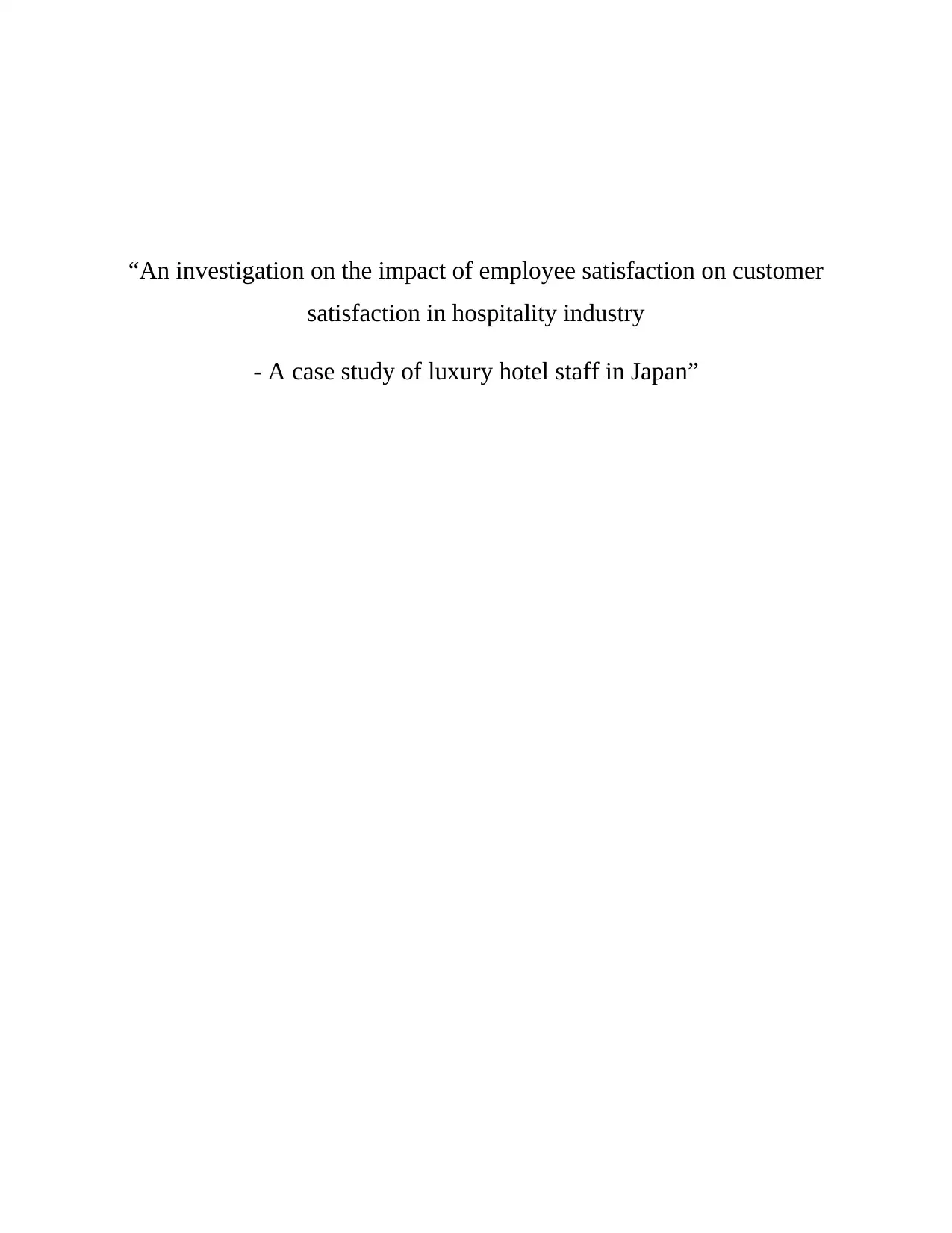
“An investigation on the impact of employee satisfaction on customer
satisfaction in hospitality industry
- A case study of luxury hotel staff in Japan”
0
satisfaction in hospitality industry
- A case study of luxury hotel staff in Japan”
0
Paraphrase This Document
Need a fresh take? Get an instant paraphrase of this document with our AI Paraphraser
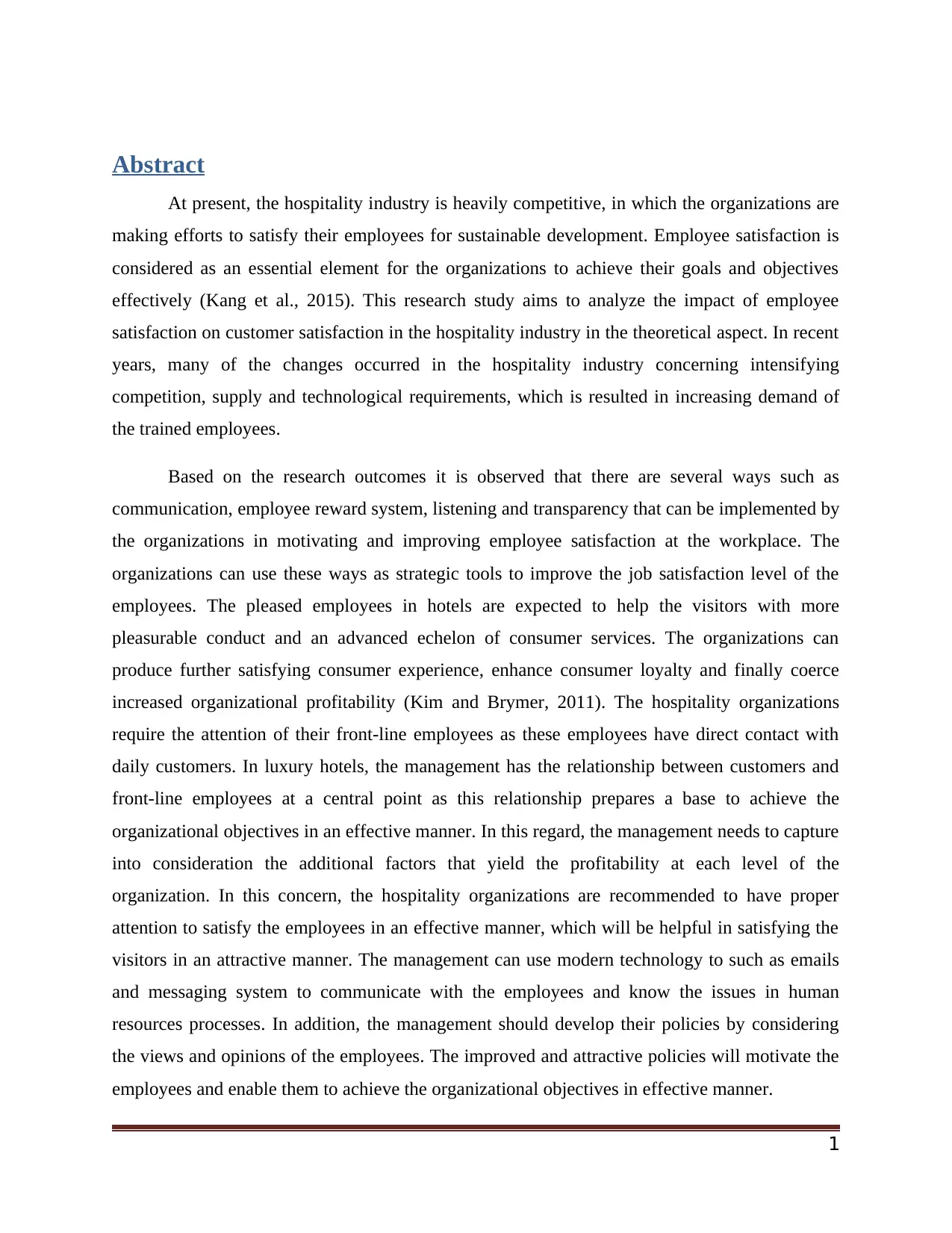
Abstract
At present, the hospitality industry is heavily competitive, in which the organizations are
making efforts to satisfy their employees for sustainable development. Employee satisfaction is
considered as an essential element for the organizations to achieve their goals and objectives
effectively (Kang et al., 2015). This research study aims to analyze the impact of employee
satisfaction on customer satisfaction in the hospitality industry in the theoretical aspect. In recent
years, many of the changes occurred in the hospitality industry concerning intensifying
competition, supply and technological requirements, which is resulted in increasing demand of
the trained employees.
Based on the research outcomes it is observed that there are several ways such as
communication, employee reward system, listening and transparency that can be implemented by
the organizations in motivating and improving employee satisfaction at the workplace. The
organizations can use these ways as strategic tools to improve the job satisfaction level of the
employees. The pleased employees in hotels are expected to help the visitors with more
pleasurable conduct and an advanced echelon of consumer services. The organizations can
produce further satisfying consumer experience, enhance consumer loyalty and finally coerce
increased organizational profitability (Kim and Brymer, 2011). The hospitality organizations
require the attention of their front-line employees as these employees have direct contact with
daily customers. In luxury hotels, the management has the relationship between customers and
front-line employees at a central point as this relationship prepares a base to achieve the
organizational objectives in an effective manner. In this regard, the management needs to capture
into consideration the additional factors that yield the profitability at each level of the
organization. In this concern, the hospitality organizations are recommended to have proper
attention to satisfy the employees in an effective manner, which will be helpful in satisfying the
visitors in an attractive manner. The management can use modern technology to such as emails
and messaging system to communicate with the employees and know the issues in human
resources processes. In addition, the management should develop their policies by considering
the views and opinions of the employees. The improved and attractive policies will motivate the
employees and enable them to achieve the organizational objectives in effective manner.
1
At present, the hospitality industry is heavily competitive, in which the organizations are
making efforts to satisfy their employees for sustainable development. Employee satisfaction is
considered as an essential element for the organizations to achieve their goals and objectives
effectively (Kang et al., 2015). This research study aims to analyze the impact of employee
satisfaction on customer satisfaction in the hospitality industry in the theoretical aspect. In recent
years, many of the changes occurred in the hospitality industry concerning intensifying
competition, supply and technological requirements, which is resulted in increasing demand of
the trained employees.
Based on the research outcomes it is observed that there are several ways such as
communication, employee reward system, listening and transparency that can be implemented by
the organizations in motivating and improving employee satisfaction at the workplace. The
organizations can use these ways as strategic tools to improve the job satisfaction level of the
employees. The pleased employees in hotels are expected to help the visitors with more
pleasurable conduct and an advanced echelon of consumer services. The organizations can
produce further satisfying consumer experience, enhance consumer loyalty and finally coerce
increased organizational profitability (Kim and Brymer, 2011). The hospitality organizations
require the attention of their front-line employees as these employees have direct contact with
daily customers. In luxury hotels, the management has the relationship between customers and
front-line employees at a central point as this relationship prepares a base to achieve the
organizational objectives in an effective manner. In this regard, the management needs to capture
into consideration the additional factors that yield the profitability at each level of the
organization. In this concern, the hospitality organizations are recommended to have proper
attention to satisfy the employees in an effective manner, which will be helpful in satisfying the
visitors in an attractive manner. The management can use modern technology to such as emails
and messaging system to communicate with the employees and know the issues in human
resources processes. In addition, the management should develop their policies by considering
the views and opinions of the employees. The improved and attractive policies will motivate the
employees and enable them to achieve the organizational objectives in effective manner.
1

Table of Contents
ABSTRACT...................................................................................................................................................................1
CHAPTER 1: INTRODUCTION................................................................................................................................5
1.1) RESEARCH BACKGROUND...................................................................................................................................5
1.2) PROBLEM STATEMENT:........................................................................................................................................8
1.3) RESEARCH AIM AND OBJECTIVES.......................................................................................................................8
1.4) RESEARCH QUESTIONS........................................................................................................................................9
1.5) SIGNIFICANCE OF THE RESEARCH.......................................................................................................................9
1.6) RESEARCH HYPOTHESIS....................................................................................................................................10
1.7) DISSERTATION STRUCTURE...............................................................................................................................10
CHAPTER 2: LITERATURE REVIEW.................................................................................................................12
2.1) EMPLOYEE SATISFACTION.................................................................................................................................12
2.2) CUSTOMER SATISFACTION.................................................................................................................................13
2.3) FACTORS THAT ARE INFLUENCING EMPLOYEE JOB SATISFACTION....................................................................13
2.4) THEORIES RELATED TO JOB SATISFACTION:......................................................................................................16
2.5) RELATIONSHIP AMONG EMPLOYEE JOB SATISFACTION AND CUSTOMER SATISFACTION IN THE HOSPITALITY
INDUSTRY OF JAPAN.................................................................................................................................................17
2.6) RECOMMENDATIONS TO IMPROVE EMPLOYEE SATISFACTION TO IMPROVE CUSTOMER SATISFACTION............18
2.7) CONCEPTUAL FRAMEWORK..............................................................................................................................23
2.7) LITERATURE GAP...............................................................................................................................................24
CHAPTER 3: RESEARCH METHODOLOGY.....................................................................................................26
3.1) INTRODUCTION..................................................................................................................................................26
3.2) RESEARCH ONION.............................................................................................................................................26
3.3) RESEARCH PHILOSOPHY....................................................................................................................................27
3.4) RESEARCH APPROACH......................................................................................................................................29
3.5) RESEARCH DESIGN............................................................................................................................................30
3.6) RESEARCH STRATEGY.......................................................................................................................................31
3.7) DATA COLLECTION METHODS..........................................................................................................................31
3.8) CONSTRUCTION OF THE QUESTIONNAIRE.........................................................................................................33
3.9) SAMPLING METHOD..........................................................................................................................................33
3.10) DATA ANALYSIS PLAN....................................................................................................................................34
3.11) ACCESSIBILITY ISSUES....................................................................................................................................35
3.12) ETHICAL ISSUES..............................................................................................................................................35
2
ABSTRACT...................................................................................................................................................................1
CHAPTER 1: INTRODUCTION................................................................................................................................5
1.1) RESEARCH BACKGROUND...................................................................................................................................5
1.2) PROBLEM STATEMENT:........................................................................................................................................8
1.3) RESEARCH AIM AND OBJECTIVES.......................................................................................................................8
1.4) RESEARCH QUESTIONS........................................................................................................................................9
1.5) SIGNIFICANCE OF THE RESEARCH.......................................................................................................................9
1.6) RESEARCH HYPOTHESIS....................................................................................................................................10
1.7) DISSERTATION STRUCTURE...............................................................................................................................10
CHAPTER 2: LITERATURE REVIEW.................................................................................................................12
2.1) EMPLOYEE SATISFACTION.................................................................................................................................12
2.2) CUSTOMER SATISFACTION.................................................................................................................................13
2.3) FACTORS THAT ARE INFLUENCING EMPLOYEE JOB SATISFACTION....................................................................13
2.4) THEORIES RELATED TO JOB SATISFACTION:......................................................................................................16
2.5) RELATIONSHIP AMONG EMPLOYEE JOB SATISFACTION AND CUSTOMER SATISFACTION IN THE HOSPITALITY
INDUSTRY OF JAPAN.................................................................................................................................................17
2.6) RECOMMENDATIONS TO IMPROVE EMPLOYEE SATISFACTION TO IMPROVE CUSTOMER SATISFACTION............18
2.7) CONCEPTUAL FRAMEWORK..............................................................................................................................23
2.7) LITERATURE GAP...............................................................................................................................................24
CHAPTER 3: RESEARCH METHODOLOGY.....................................................................................................26
3.1) INTRODUCTION..................................................................................................................................................26
3.2) RESEARCH ONION.............................................................................................................................................26
3.3) RESEARCH PHILOSOPHY....................................................................................................................................27
3.4) RESEARCH APPROACH......................................................................................................................................29
3.5) RESEARCH DESIGN............................................................................................................................................30
3.6) RESEARCH STRATEGY.......................................................................................................................................31
3.7) DATA COLLECTION METHODS..........................................................................................................................31
3.8) CONSTRUCTION OF THE QUESTIONNAIRE.........................................................................................................33
3.9) SAMPLING METHOD..........................................................................................................................................33
3.10) DATA ANALYSIS PLAN....................................................................................................................................34
3.11) ACCESSIBILITY ISSUES....................................................................................................................................35
3.12) ETHICAL ISSUES..............................................................................................................................................35
2
⊘ This is a preview!⊘
Do you want full access?
Subscribe today to unlock all pages.

Trusted by 1+ million students worldwide

3.13) RESEARCH LIMITATIONS.................................................................................................................................35
3.14) SUMMARY.......................................................................................................................................................36
3.15) RESEARCH TIMESCALE....................................................................................................................................36
CHAPTER 4: DATA ANALYSIS AND INTERPRETATION..............................................................................38
4.1) INTRODUCTION..................................................................................................................................................38
4.2) ANALYSIS OF THE RESULTS OF PRIMARY RESEARCH........................................................................................38
4.3) RELATING THE FINDINGS OF PRIMARY RESEARCH WITH LITERATURE............................................................51
4.4) TESTING OF HYPOTHESIS AND RESULTS...........................................................................................................56
CHAPTER 5: CONCLUSION AND RECOMMENDATIONS.............................................................................58
5.1) CONCLUSION.....................................................................................................................................................58
5.2) RECOMMENDATIONS.........................................................................................................................................60
5.3) RESEARCH LIMITATIONS...................................................................................................................................63
5.4) FUTURE RESEARCH IMPLICATIONS...................................................................................................................64
REFERENCES............................................................................................................................................................65
APPENDIX 1: QUESTIONNAIRE..........................................................................................................................71
APPENDIX 2: DATA SHEET...................................................................................................................................76
APPENDIX 3: DATA GRAPH..................................................................................................................................83
Appendix 4: Ethics........................................................................................................................................................90
3
3.14) SUMMARY.......................................................................................................................................................36
3.15) RESEARCH TIMESCALE....................................................................................................................................36
CHAPTER 4: DATA ANALYSIS AND INTERPRETATION..............................................................................38
4.1) INTRODUCTION..................................................................................................................................................38
4.2) ANALYSIS OF THE RESULTS OF PRIMARY RESEARCH........................................................................................38
4.3) RELATING THE FINDINGS OF PRIMARY RESEARCH WITH LITERATURE............................................................51
4.4) TESTING OF HYPOTHESIS AND RESULTS...........................................................................................................56
CHAPTER 5: CONCLUSION AND RECOMMENDATIONS.............................................................................58
5.1) CONCLUSION.....................................................................................................................................................58
5.2) RECOMMENDATIONS.........................................................................................................................................60
5.3) RESEARCH LIMITATIONS...................................................................................................................................63
5.4) FUTURE RESEARCH IMPLICATIONS...................................................................................................................64
REFERENCES............................................................................................................................................................65
APPENDIX 1: QUESTIONNAIRE..........................................................................................................................71
APPENDIX 2: DATA SHEET...................................................................................................................................76
APPENDIX 3: DATA GRAPH..................................................................................................................................83
Appendix 4: Ethics........................................................................................................................................................90
3
Paraphrase This Document
Need a fresh take? Get an instant paraphrase of this document with our AI Paraphraser

Chapter 1: Introduction
The research is describing the impact of employee satisfaction on customer satisfaction in the
hospitality industry in Japan. This research discusses the role of employee satisfaction in
improving the customer services in luxury hotels. In addition, the research is also explaining the
different method by which employee satisfaction can be enhanced. The research is investigating
various methods such as training and development programs and organizational policies for the
employees to improve their performance and motivate employee them to perform with more
efficiency for customer satisfaction. In this concern, Grand Hyatt Tokyo is considered to
understand the research issue in a better way.
1.1) Research Background
The research study proposes to explore the impact of employee satisfaction on customer
satisfaction in the hospitality industry in Japan. In recent years, many of the changes occurred in
the hospitality industry with respect to intensifying competition, supply and technological
requirements, which is resulted in increasing demand of the trained employees. In addition, the
satisfied employees work with more efforts, which lead to increased services. The increased
level of services attracts more customers (Wustenhagen and Menichetti, 2012). Therefore, the
customer satisfaction is a dependent variable, which is depended on employee satisfaction. The
hospitality industry of Japan is growing rapidly and attracting to domestic and international
investors, but the employees are not satisfied with their career development.
In Japan ‘Omotenashi' is termed to treat the guests traditionally. This term is used as a guiding
principle for the hospitality industry. In recent, it is observed that the development of new hotels
is accelerating against the growing number of inbound tourist. The luxury hotels are improving
their working environments and focusing on the satisfaction level of their employees. Lee and
Ok (2012) stated that employee job satisfaction plays an immense role in satisfying the customer.
The satisfied workers with their job or position in the organization will be dedicated to providing
better and improved services to the consumers and ultimately can enlarge organizational
profitability. The management of the luxury hotels understands the employee desires from the
organization and tries to satisfy their expectations in an effective manner. The management
believes that satisfied employees can deliver better services to the visitors. In this concern, there
4
The research is describing the impact of employee satisfaction on customer satisfaction in the
hospitality industry in Japan. This research discusses the role of employee satisfaction in
improving the customer services in luxury hotels. In addition, the research is also explaining the
different method by which employee satisfaction can be enhanced. The research is investigating
various methods such as training and development programs and organizational policies for the
employees to improve their performance and motivate employee them to perform with more
efficiency for customer satisfaction. In this concern, Grand Hyatt Tokyo is considered to
understand the research issue in a better way.
1.1) Research Background
The research study proposes to explore the impact of employee satisfaction on customer
satisfaction in the hospitality industry in Japan. In recent years, many of the changes occurred in
the hospitality industry with respect to intensifying competition, supply and technological
requirements, which is resulted in increasing demand of the trained employees. In addition, the
satisfied employees work with more efforts, which lead to increased services. The increased
level of services attracts more customers (Wustenhagen and Menichetti, 2012). Therefore, the
customer satisfaction is a dependent variable, which is depended on employee satisfaction. The
hospitality industry of Japan is growing rapidly and attracting to domestic and international
investors, but the employees are not satisfied with their career development.
In Japan ‘Omotenashi' is termed to treat the guests traditionally. This term is used as a guiding
principle for the hospitality industry. In recent, it is observed that the development of new hotels
is accelerating against the growing number of inbound tourist. The luxury hotels are improving
their working environments and focusing on the satisfaction level of their employees. Lee and
Ok (2012) stated that employee job satisfaction plays an immense role in satisfying the customer.
The satisfied workers with their job or position in the organization will be dedicated to providing
better and improved services to the consumers and ultimately can enlarge organizational
profitability. The management of the luxury hotels understands the employee desires from the
organization and tries to satisfy their expectations in an effective manner. The management
believes that satisfied employees can deliver better services to the visitors. In this concern, there
4
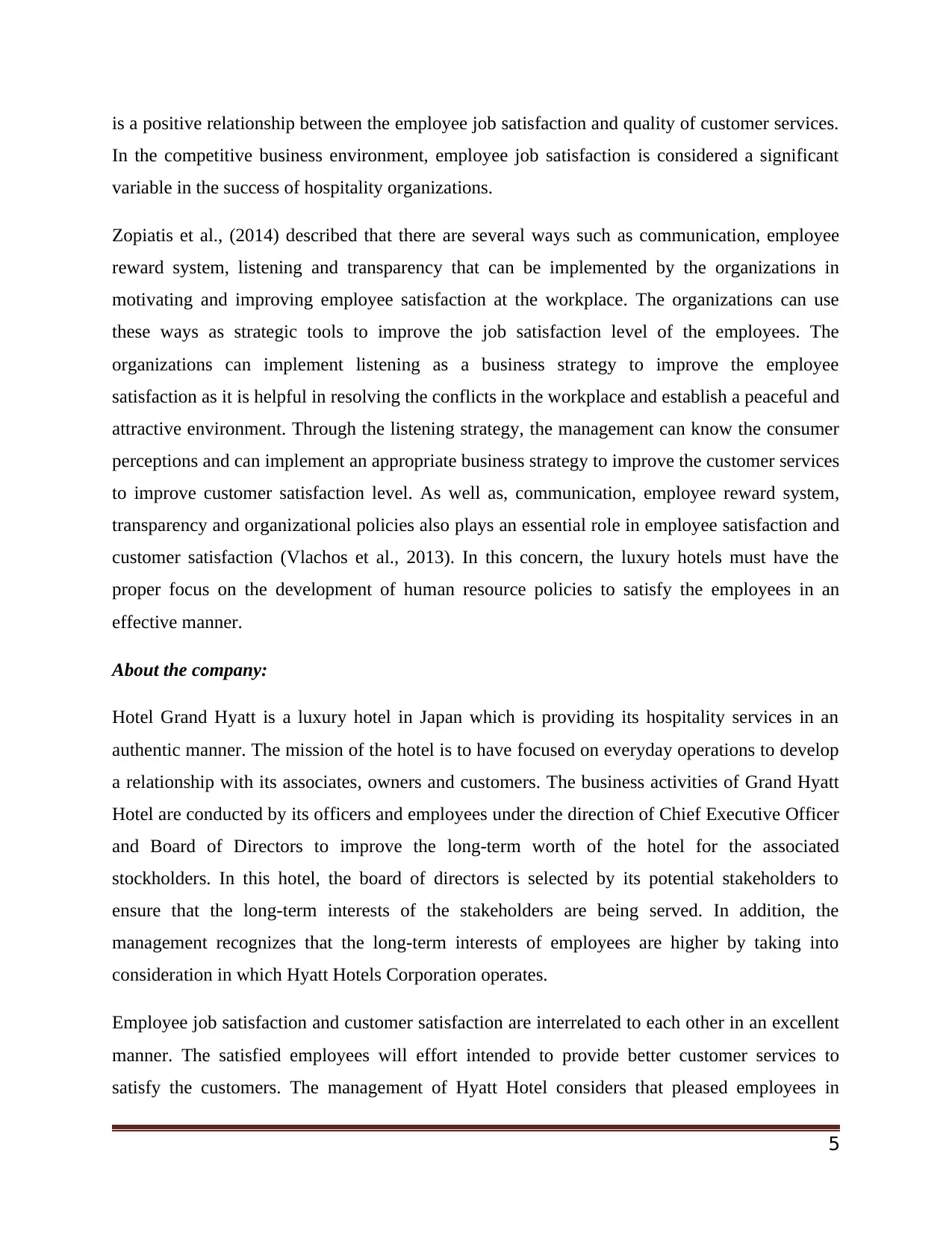
is a positive relationship between the employee job satisfaction and quality of customer services.
In the competitive business environment, employee job satisfaction is considered a significant
variable in the success of hospitality organizations.
Zopiatis et al., (2014) described that there are several ways such as communication, employee
reward system, listening and transparency that can be implemented by the organizations in
motivating and improving employee satisfaction at the workplace. The organizations can use
these ways as strategic tools to improve the job satisfaction level of the employees. The
organizations can implement listening as a business strategy to improve the employee
satisfaction as it is helpful in resolving the conflicts in the workplace and establish a peaceful and
attractive environment. Through the listening strategy, the management can know the consumer
perceptions and can implement an appropriate business strategy to improve the customer services
to improve customer satisfaction level. As well as, communication, employee reward system,
transparency and organizational policies also plays an essential role in employee satisfaction and
customer satisfaction (Vlachos et al., 2013). In this concern, the luxury hotels must have the
proper focus on the development of human resource policies to satisfy the employees in an
effective manner.
About the company:
Hotel Grand Hyatt is a luxury hotel in Japan which is providing its hospitality services in an
authentic manner. The mission of the hotel is to have focused on everyday operations to develop
a relationship with its associates, owners and customers. The business activities of Grand Hyatt
Hotel are conducted by its officers and employees under the direction of Chief Executive Officer
and Board of Directors to improve the long-term worth of the hotel for the associated
stockholders. In this hotel, the board of directors is selected by its potential stakeholders to
ensure that the long-term interests of the stakeholders are being served. In addition, the
management recognizes that the long-term interests of employees are higher by taking into
consideration in which Hyatt Hotels Corporation operates.
Employee job satisfaction and customer satisfaction are interrelated to each other in an excellent
manner. The satisfied employees will effort intended to provide better customer services to
satisfy the customers. The management of Hyatt Hotel considers that pleased employees in
5
In the competitive business environment, employee job satisfaction is considered a significant
variable in the success of hospitality organizations.
Zopiatis et al., (2014) described that there are several ways such as communication, employee
reward system, listening and transparency that can be implemented by the organizations in
motivating and improving employee satisfaction at the workplace. The organizations can use
these ways as strategic tools to improve the job satisfaction level of the employees. The
organizations can implement listening as a business strategy to improve the employee
satisfaction as it is helpful in resolving the conflicts in the workplace and establish a peaceful and
attractive environment. Through the listening strategy, the management can know the consumer
perceptions and can implement an appropriate business strategy to improve the customer services
to improve customer satisfaction level. As well as, communication, employee reward system,
transparency and organizational policies also plays an essential role in employee satisfaction and
customer satisfaction (Vlachos et al., 2013). In this concern, the luxury hotels must have the
proper focus on the development of human resource policies to satisfy the employees in an
effective manner.
About the company:
Hotel Grand Hyatt is a luxury hotel in Japan which is providing its hospitality services in an
authentic manner. The mission of the hotel is to have focused on everyday operations to develop
a relationship with its associates, owners and customers. The business activities of Grand Hyatt
Hotel are conducted by its officers and employees under the direction of Chief Executive Officer
and Board of Directors to improve the long-term worth of the hotel for the associated
stockholders. In this hotel, the board of directors is selected by its potential stakeholders to
ensure that the long-term interests of the stakeholders are being served. In addition, the
management recognizes that the long-term interests of employees are higher by taking into
consideration in which Hyatt Hotels Corporation operates.
Employee job satisfaction and customer satisfaction are interrelated to each other in an excellent
manner. The satisfied employees will effort intended to provide better customer services to
satisfy the customers. The management of Hyatt Hotel considers that pleased employees in
5
⊘ This is a preview!⊘
Do you want full access?
Subscribe today to unlock all pages.

Trusted by 1+ million students worldwide

hotels are expected to help the visitors with more pleasurable conduct and an advanced echelon
of consumer services. The organizations can produce further satisfying consumer experience,
enhance consumer loyalty and finally coerce increased organizational profitability. An effective
CRM (Customer Relationship Management) program is a helpful hospitality organization in
satisfying the customer. In this concern, the research study will discover diverse methods and
techniques for establishing effective CRM to satisfy the customers (Hassan et al., 2015). Meeting
the needs of employees and customers from a specific organization are denoted as satisfaction.
Therefore, each of the organization has their own elements to satisfy employees and customers to
improve the organizational profitability. It may be higher, lower, or equal in term of motivation,
expectation and fulfillment of need is satisfied. Employee satisfaction is based on the
achievement of vision and mission, on other side customer satisfaction is necessary for any
organization. In the present era, the balanced scorecard is considered as a significant strategic
initiative to implement the organizational policies for different stakeholders. Financial and
nonfinancial factors have implemented a system for the growth of an organization with proper
responses from the consumer. The balanced scorecard is helpful in providing the measurable
improvements in job satisfaction, employee retention, financial growth and customer relationship
in excellence manner (Sageer et al., 2012). Thus, the balanced scorecard is a useful tool for
improving the job satisfaction and customer satisfaction.
1.2) Problem statement:
The company is facing issues of employee satisfaction, which is influencing on the satisfaction
level of its customers. It is essential for an organization to have satisfied employees to provide
better customer services. In addition, the company is also facing the employee concerns
regarding employee policies so that the research study will be helpful in identifying the factors
that are influencing employee satisfaction as well as customer satisfaction (Pelit et al., 2011).
1.3) Research Aim and Objectives
The aim of the research study is to investigate the impact of employee satisfaction on customer
satisfaction level in the hospitality industry, which can be achieved through the strong
understanding and investigation of the below research objectives:
6
of consumer services. The organizations can produce further satisfying consumer experience,
enhance consumer loyalty and finally coerce increased organizational profitability. An effective
CRM (Customer Relationship Management) program is a helpful hospitality organization in
satisfying the customer. In this concern, the research study will discover diverse methods and
techniques for establishing effective CRM to satisfy the customers (Hassan et al., 2015). Meeting
the needs of employees and customers from a specific organization are denoted as satisfaction.
Therefore, each of the organization has their own elements to satisfy employees and customers to
improve the organizational profitability. It may be higher, lower, or equal in term of motivation,
expectation and fulfillment of need is satisfied. Employee satisfaction is based on the
achievement of vision and mission, on other side customer satisfaction is necessary for any
organization. In the present era, the balanced scorecard is considered as a significant strategic
initiative to implement the organizational policies for different stakeholders. Financial and
nonfinancial factors have implemented a system for the growth of an organization with proper
responses from the consumer. The balanced scorecard is helpful in providing the measurable
improvements in job satisfaction, employee retention, financial growth and customer relationship
in excellence manner (Sageer et al., 2012). Thus, the balanced scorecard is a useful tool for
improving the job satisfaction and customer satisfaction.
1.2) Problem statement:
The company is facing issues of employee satisfaction, which is influencing on the satisfaction
level of its customers. It is essential for an organization to have satisfied employees to provide
better customer services. In addition, the company is also facing the employee concerns
regarding employee policies so that the research study will be helpful in identifying the factors
that are influencing employee satisfaction as well as customer satisfaction (Pelit et al., 2011).
1.3) Research Aim and Objectives
The aim of the research study is to investigate the impact of employee satisfaction on customer
satisfaction level in the hospitality industry, which can be achieved through the strong
understanding and investigation of the below research objectives:
6
Paraphrase This Document
Need a fresh take? Get an instant paraphrase of this document with our AI Paraphraser

To analyze the factors affecting employee job satisfaction and current satisfaction level of
employees
To analyze the factors affecting customer satisfaction
To investigate the relationship among employee job satisfaction and customer satisfaction
in the hospitality industry of Japan
To recommend the ways to manage to improve employee satisfaction to improve
customer satisfaction
1.4) Research Questions
Below are the research questions that would answer throughout the research study:
What is the role of job engagement in improving customer satisfaction?
What are the key drivers of job satisfaction?
What is the relationship between employee job satisfaction and customer satisfaction in
the hospitality industry?
How the CRM practices influence on customer satisfaction?
Will the satisfied employees improve customer satisfaction?
Can the organizations improve employee satisfaction through providing growth and
development opportunities for the employees?
What are the ways to improve customer satisfaction through employee satisfaction?
1.5) Significance of the Research
The research study is helpful for the hospitality organizations to improve customer satisfaction
through employee satisfaction. It is essential for the organizations to implement different
organizational policies to satisfy the employees and retain the skilled and experienced
employees. The research outcomes will be helpful for the management in making an attractive
employee policy to satisfy the employees at the workplace. The attractive organizational policies
would be beneficial for the organizations in improving employee satisfaction level and retain the
skilled employees for long-term (Brun and Cooper, 2016). In this concern, the research discusses
the impact of the employee satisfaction on customer satisfaction in the hospitality industry. In
this concern, the research study has significance for the researcher and readers about the
importance of employee satisfaction in the hospitality industry.
7
employees
To analyze the factors affecting customer satisfaction
To investigate the relationship among employee job satisfaction and customer satisfaction
in the hospitality industry of Japan
To recommend the ways to manage to improve employee satisfaction to improve
customer satisfaction
1.4) Research Questions
Below are the research questions that would answer throughout the research study:
What is the role of job engagement in improving customer satisfaction?
What are the key drivers of job satisfaction?
What is the relationship between employee job satisfaction and customer satisfaction in
the hospitality industry?
How the CRM practices influence on customer satisfaction?
Will the satisfied employees improve customer satisfaction?
Can the organizations improve employee satisfaction through providing growth and
development opportunities for the employees?
What are the ways to improve customer satisfaction through employee satisfaction?
1.5) Significance of the Research
The research study is helpful for the hospitality organizations to improve customer satisfaction
through employee satisfaction. It is essential for the organizations to implement different
organizational policies to satisfy the employees and retain the skilled and experienced
employees. The research outcomes will be helpful for the management in making an attractive
employee policy to satisfy the employees at the workplace. The attractive organizational policies
would be beneficial for the organizations in improving employee satisfaction level and retain the
skilled employees for long-term (Brun and Cooper, 2016). In this concern, the research discusses
the impact of the employee satisfaction on customer satisfaction in the hospitality industry. In
this concern, the research study has significance for the researcher and readers about the
importance of employee satisfaction in the hospitality industry.
7
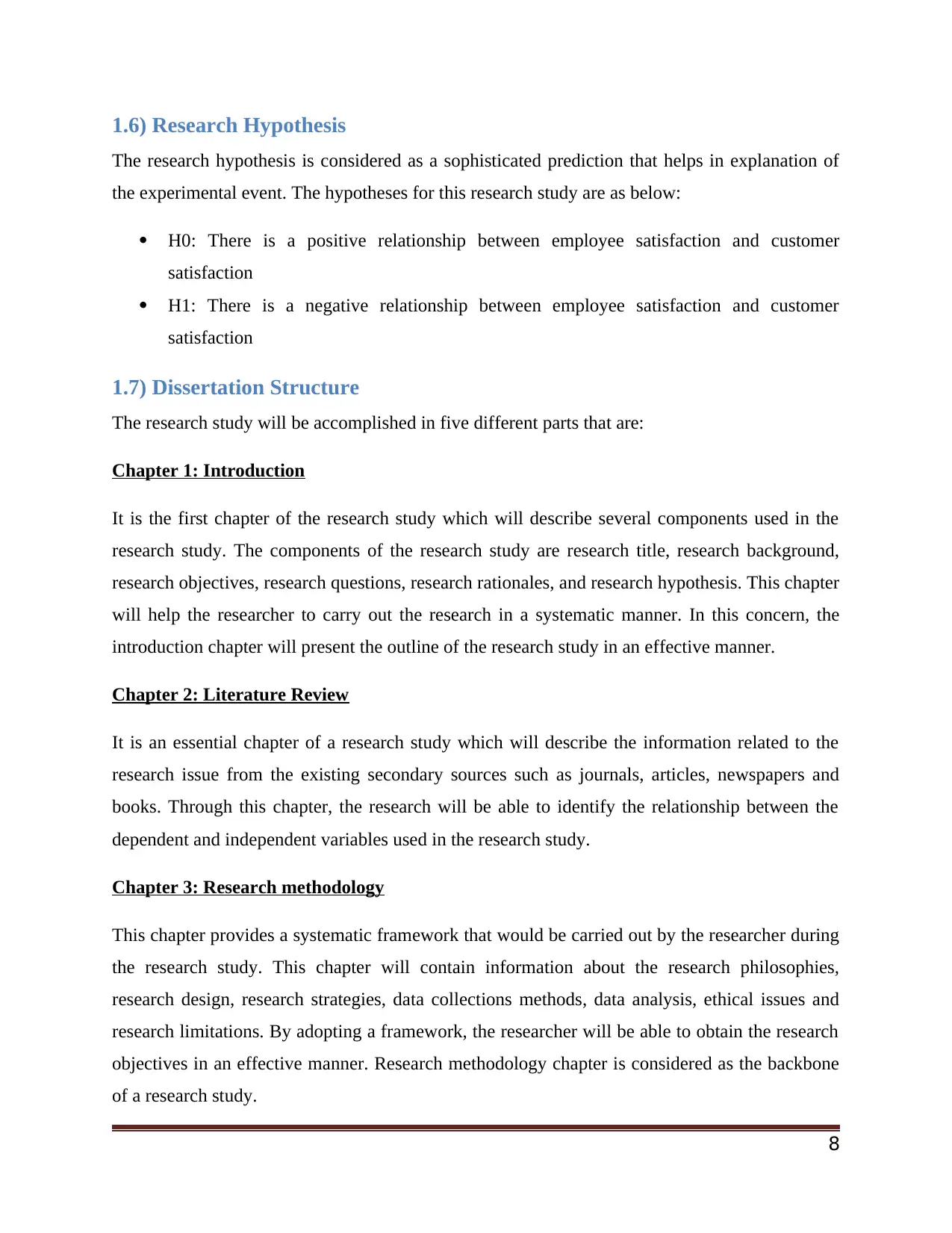
1.6) Research Hypothesis
The research hypothesis is considered as a sophisticated prediction that helps in explanation of
the experimental event. The hypotheses for this research study are as below:
H0: There is a positive relationship between employee satisfaction and customer
satisfaction
H1: There is a negative relationship between employee satisfaction and customer
satisfaction
1.7) Dissertation Structure
The research study will be accomplished in five different parts that are:
Chapter 1: Introduction
It is the first chapter of the research study which will describe several components used in the
research study. The components of the research study are research title, research background,
research objectives, research questions, research rationales, and research hypothesis. This chapter
will help the researcher to carry out the research in a systematic manner. In this concern, the
introduction chapter will present the outline of the research study in an effective manner.
Chapter 2: Literature Review
It is an essential chapter of a research study which will describe the information related to the
research issue from the existing secondary sources such as journals, articles, newspapers and
books. Through this chapter, the research will be able to identify the relationship between the
dependent and independent variables used in the research study.
Chapter 3: Research methodology
This chapter provides a systematic framework that would be carried out by the researcher during
the research study. This chapter will contain information about the research philosophies,
research design, research strategies, data collections methods, data analysis, ethical issues and
research limitations. By adopting a framework, the researcher will be able to obtain the research
objectives in an effective manner. Research methodology chapter is considered as the backbone
of a research study.
8
The research hypothesis is considered as a sophisticated prediction that helps in explanation of
the experimental event. The hypotheses for this research study are as below:
H0: There is a positive relationship between employee satisfaction and customer
satisfaction
H1: There is a negative relationship between employee satisfaction and customer
satisfaction
1.7) Dissertation Structure
The research study will be accomplished in five different parts that are:
Chapter 1: Introduction
It is the first chapter of the research study which will describe several components used in the
research study. The components of the research study are research title, research background,
research objectives, research questions, research rationales, and research hypothesis. This chapter
will help the researcher to carry out the research in a systematic manner. In this concern, the
introduction chapter will present the outline of the research study in an effective manner.
Chapter 2: Literature Review
It is an essential chapter of a research study which will describe the information related to the
research issue from the existing secondary sources such as journals, articles, newspapers and
books. Through this chapter, the research will be able to identify the relationship between the
dependent and independent variables used in the research study.
Chapter 3: Research methodology
This chapter provides a systematic framework that would be carried out by the researcher during
the research study. This chapter will contain information about the research philosophies,
research design, research strategies, data collections methods, data analysis, ethical issues and
research limitations. By adopting a framework, the researcher will be able to obtain the research
objectives in an effective manner. Research methodology chapter is considered as the backbone
of a research study.
8
⊘ This is a preview!⊘
Do you want full access?
Subscribe today to unlock all pages.

Trusted by 1+ million students worldwide
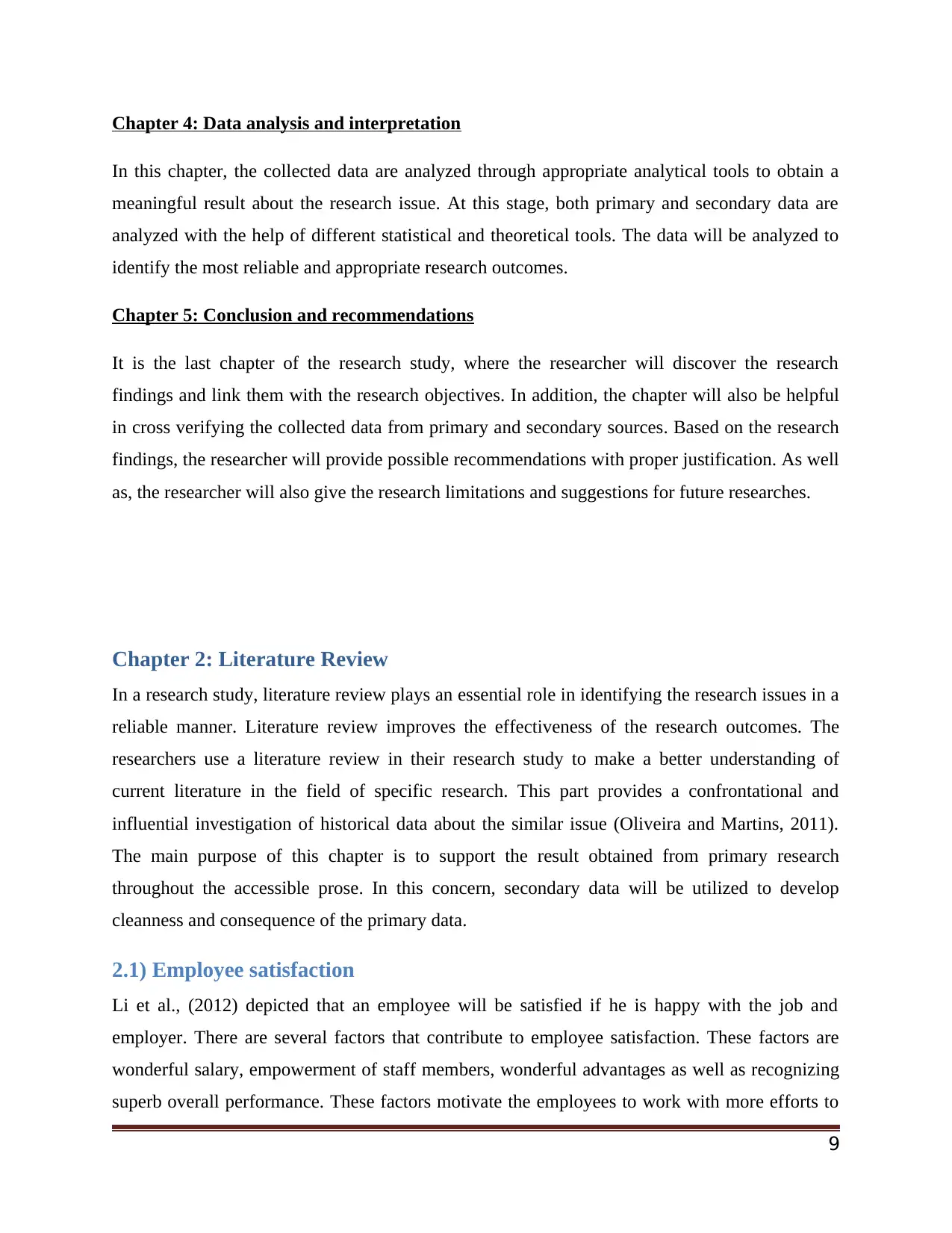
Chapter 4: Data analysis and interpretation
In this chapter, the collected data are analyzed through appropriate analytical tools to obtain a
meaningful result about the research issue. At this stage, both primary and secondary data are
analyzed with the help of different statistical and theoretical tools. The data will be analyzed to
identify the most reliable and appropriate research outcomes.
Chapter 5: Conclusion and recommendations
It is the last chapter of the research study, where the researcher will discover the research
findings and link them with the research objectives. In addition, the chapter will also be helpful
in cross verifying the collected data from primary and secondary sources. Based on the research
findings, the researcher will provide possible recommendations with proper justification. As well
as, the researcher will also give the research limitations and suggestions for future researches.
Chapter 2: Literature Review
In a research study, literature review plays an essential role in identifying the research issues in a
reliable manner. Literature review improves the effectiveness of the research outcomes. The
researchers use a literature review in their research study to make a better understanding of
current literature in the field of specific research. This part provides a confrontational and
influential investigation of historical data about the similar issue (Oliveira and Martins, 2011).
The main purpose of this chapter is to support the result obtained from primary research
throughout the accessible prose. In this concern, secondary data will be utilized to develop
cleanness and consequence of the primary data.
2.1) Employee satisfaction
Li et al., (2012) depicted that an employee will be satisfied if he is happy with the job and
employer. There are several factors that contribute to employee satisfaction. These factors are
wonderful salary, empowerment of staff members, wonderful advantages as well as recognizing
superb overall performance. These factors motivate the employees to work with more efforts to
9
In this chapter, the collected data are analyzed through appropriate analytical tools to obtain a
meaningful result about the research issue. At this stage, both primary and secondary data are
analyzed with the help of different statistical and theoretical tools. The data will be analyzed to
identify the most reliable and appropriate research outcomes.
Chapter 5: Conclusion and recommendations
It is the last chapter of the research study, where the researcher will discover the research
findings and link them with the research objectives. In addition, the chapter will also be helpful
in cross verifying the collected data from primary and secondary sources. Based on the research
findings, the researcher will provide possible recommendations with proper justification. As well
as, the researcher will also give the research limitations and suggestions for future researches.
Chapter 2: Literature Review
In a research study, literature review plays an essential role in identifying the research issues in a
reliable manner. Literature review improves the effectiveness of the research outcomes. The
researchers use a literature review in their research study to make a better understanding of
current literature in the field of specific research. This part provides a confrontational and
influential investigation of historical data about the similar issue (Oliveira and Martins, 2011).
The main purpose of this chapter is to support the result obtained from primary research
throughout the accessible prose. In this concern, secondary data will be utilized to develop
cleanness and consequence of the primary data.
2.1) Employee satisfaction
Li et al., (2012) depicted that an employee will be satisfied if he is happy with the job and
employer. There are several factors that contribute to employee satisfaction. These factors are
wonderful salary, empowerment of staff members, wonderful advantages as well as recognizing
superb overall performance. These factors motivate the employees to work with more efforts to
9
Paraphrase This Document
Need a fresh take? Get an instant paraphrase of this document with our AI Paraphraser
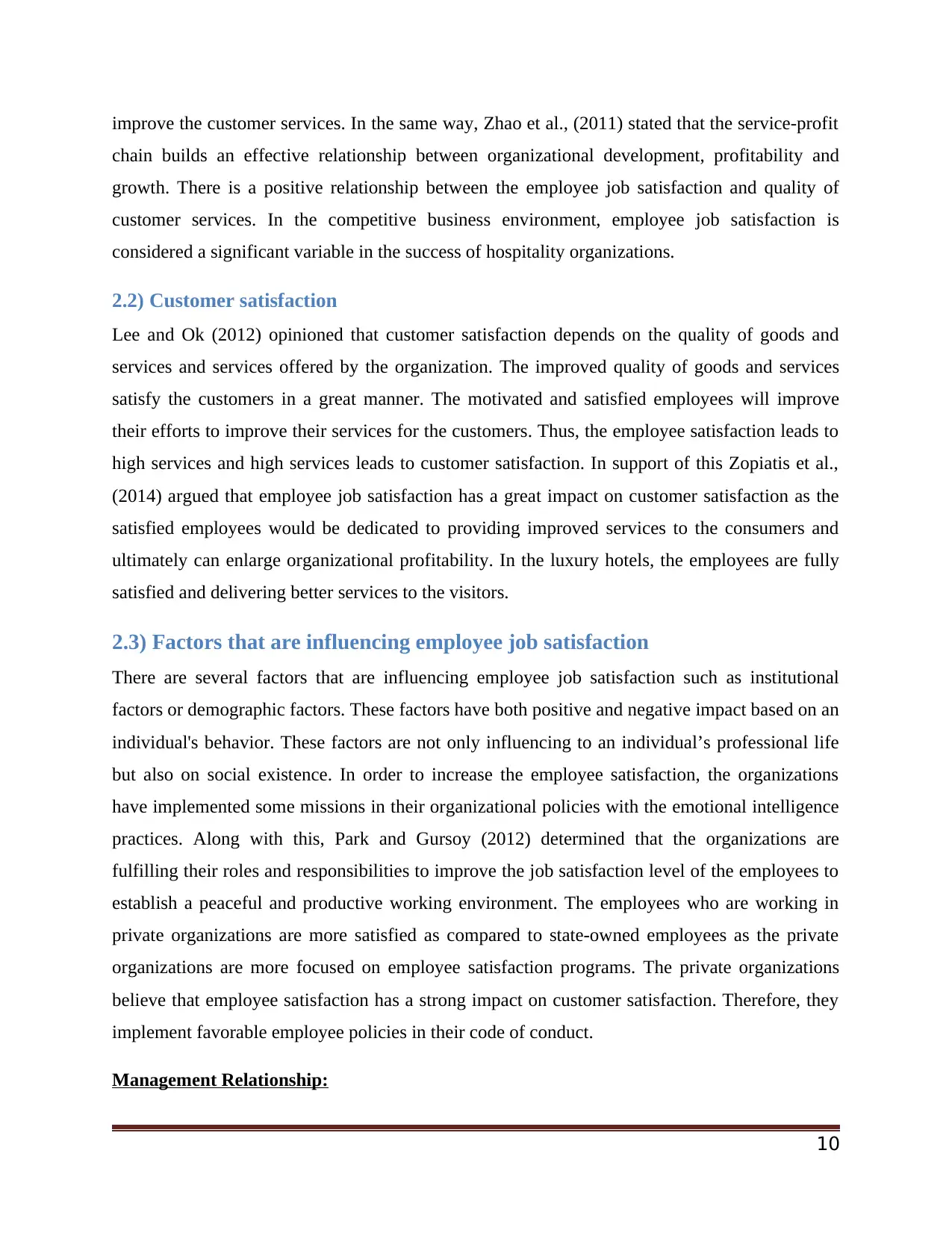
improve the customer services. In the same way, Zhao et al., (2011) stated that the service-profit
chain builds an effective relationship between organizational development, profitability and
growth. There is a positive relationship between the employee job satisfaction and quality of
customer services. In the competitive business environment, employee job satisfaction is
considered a significant variable in the success of hospitality organizations.
2.2) Customer satisfaction
Lee and Ok (2012) opinioned that customer satisfaction depends on the quality of goods and
services and services offered by the organization. The improved quality of goods and services
satisfy the customers in a great manner. The motivated and satisfied employees will improve
their efforts to improve their services for the customers. Thus, the employee satisfaction leads to
high services and high services leads to customer satisfaction. In support of this Zopiatis et al.,
(2014) argued that employee job satisfaction has a great impact on customer satisfaction as the
satisfied employees would be dedicated to providing improved services to the consumers and
ultimately can enlarge organizational profitability. In the luxury hotels, the employees are fully
satisfied and delivering better services to the visitors.
2.3) Factors that are influencing employee job satisfaction
There are several factors that are influencing employee job satisfaction such as institutional
factors or demographic factors. These factors have both positive and negative impact based on an
individual's behavior. These factors are not only influencing to an individual’s professional life
but also on social existence. In order to increase the employee satisfaction, the organizations
have implemented some missions in their organizational policies with the emotional intelligence
practices. Along with this, Park and Gursoy (2012) determined that the organizations are
fulfilling their roles and responsibilities to improve the job satisfaction level of the employees to
establish a peaceful and productive working environment. The employees who are working in
private organizations are more satisfied as compared to state-owned employees as the private
organizations are more focused on employee satisfaction programs. The private organizations
believe that employee satisfaction has a strong impact on customer satisfaction. Therefore, they
implement favorable employee policies in their code of conduct.
Management Relationship:
10
chain builds an effective relationship between organizational development, profitability and
growth. There is a positive relationship between the employee job satisfaction and quality of
customer services. In the competitive business environment, employee job satisfaction is
considered a significant variable in the success of hospitality organizations.
2.2) Customer satisfaction
Lee and Ok (2012) opinioned that customer satisfaction depends on the quality of goods and
services and services offered by the organization. The improved quality of goods and services
satisfy the customers in a great manner. The motivated and satisfied employees will improve
their efforts to improve their services for the customers. Thus, the employee satisfaction leads to
high services and high services leads to customer satisfaction. In support of this Zopiatis et al.,
(2014) argued that employee job satisfaction has a great impact on customer satisfaction as the
satisfied employees would be dedicated to providing improved services to the consumers and
ultimately can enlarge organizational profitability. In the luxury hotels, the employees are fully
satisfied and delivering better services to the visitors.
2.3) Factors that are influencing employee job satisfaction
There are several factors that are influencing employee job satisfaction such as institutional
factors or demographic factors. These factors have both positive and negative impact based on an
individual's behavior. These factors are not only influencing to an individual’s professional life
but also on social existence. In order to increase the employee satisfaction, the organizations
have implemented some missions in their organizational policies with the emotional intelligence
practices. Along with this, Park and Gursoy (2012) determined that the organizations are
fulfilling their roles and responsibilities to improve the job satisfaction level of the employees to
establish a peaceful and productive working environment. The employees who are working in
private organizations are more satisfied as compared to state-owned employees as the private
organizations are more focused on employee satisfaction programs. The private organizations
believe that employee satisfaction has a strong impact on customer satisfaction. Therefore, they
implement favorable employee policies in their code of conduct.
Management Relationship:
10
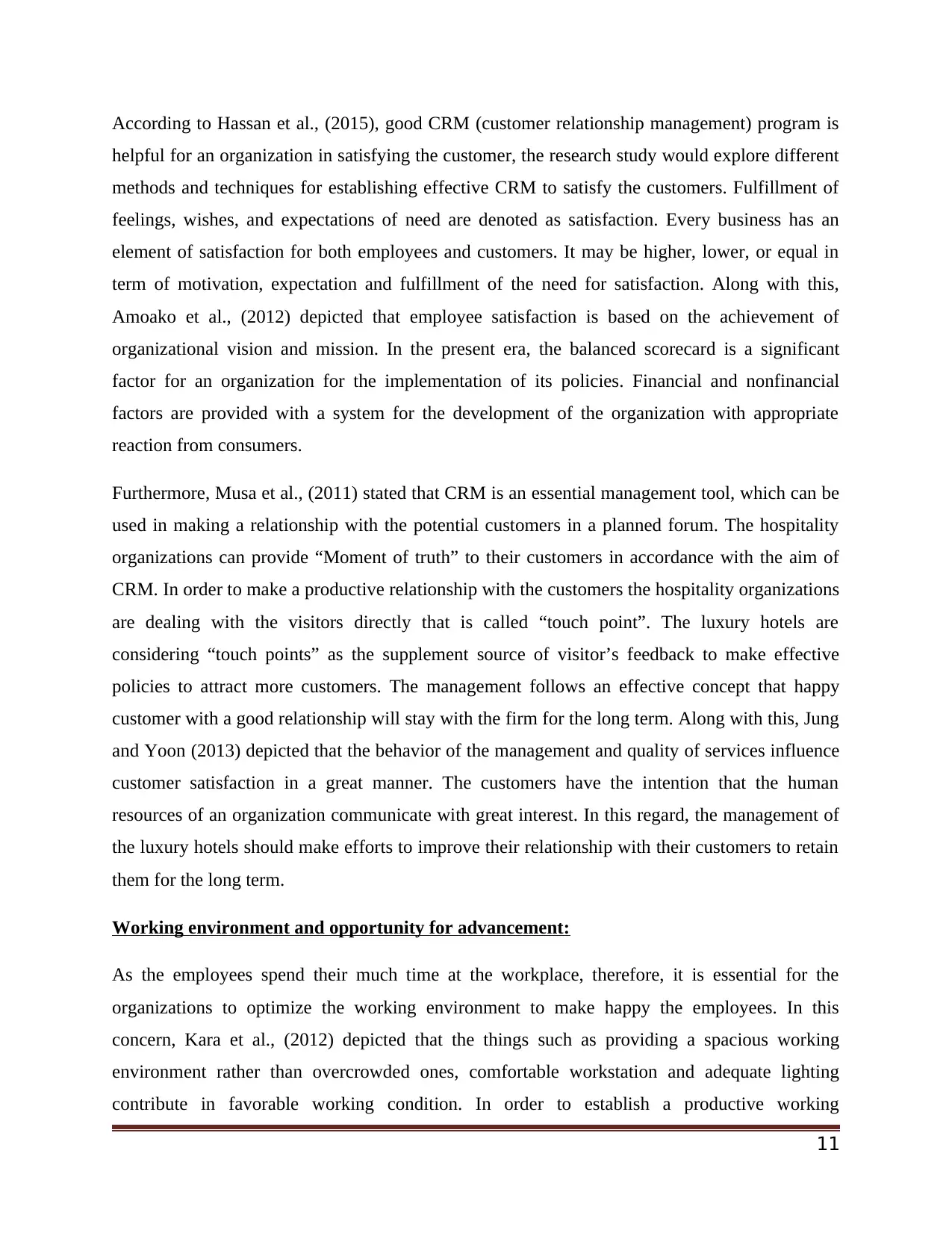
According to Hassan et al., (2015), good CRM (customer relationship management) program is
helpful for an organization in satisfying the customer, the research study would explore different
methods and techniques for establishing effective CRM to satisfy the customers. Fulfillment of
feelings, wishes, and expectations of need are denoted as satisfaction. Every business has an
element of satisfaction for both employees and customers. It may be higher, lower, or equal in
term of motivation, expectation and fulfillment of the need for satisfaction. Along with this,
Amoako et al., (2012) depicted that employee satisfaction is based on the achievement of
organizational vision and mission. In the present era, the balanced scorecard is a significant
factor for an organization for the implementation of its policies. Financial and nonfinancial
factors are provided with a system for the development of the organization with appropriate
reaction from consumers.
Furthermore, Musa et al., (2011) stated that CRM is an essential management tool, which can be
used in making a relationship with the potential customers in a planned forum. The hospitality
organizations can provide “Moment of truth” to their customers in accordance with the aim of
CRM. In order to make a productive relationship with the customers the hospitality organizations
are dealing with the visitors directly that is called “touch point”. The luxury hotels are
considering “touch points” as the supplement source of visitor’s feedback to make effective
policies to attract more customers. The management follows an effective concept that happy
customer with a good relationship will stay with the firm for the long term. Along with this, Jung
and Yoon (2013) depicted that the behavior of the management and quality of services influence
customer satisfaction in a great manner. The customers have the intention that the human
resources of an organization communicate with great interest. In this regard, the management of
the luxury hotels should make efforts to improve their relationship with their customers to retain
them for the long term.
Working environment and opportunity for advancement:
As the employees spend their much time at the workplace, therefore, it is essential for the
organizations to optimize the working environment to make happy the employees. In this
concern, Kara et al., (2012) depicted that the things such as providing a spacious working
environment rather than overcrowded ones, comfortable workstation and adequate lighting
contribute in favorable working condition. In order to establish a productive working
11
helpful for an organization in satisfying the customer, the research study would explore different
methods and techniques for establishing effective CRM to satisfy the customers. Fulfillment of
feelings, wishes, and expectations of need are denoted as satisfaction. Every business has an
element of satisfaction for both employees and customers. It may be higher, lower, or equal in
term of motivation, expectation and fulfillment of the need for satisfaction. Along with this,
Amoako et al., (2012) depicted that employee satisfaction is based on the achievement of
organizational vision and mission. In the present era, the balanced scorecard is a significant
factor for an organization for the implementation of its policies. Financial and nonfinancial
factors are provided with a system for the development of the organization with appropriate
reaction from consumers.
Furthermore, Musa et al., (2011) stated that CRM is an essential management tool, which can be
used in making a relationship with the potential customers in a planned forum. The hospitality
organizations can provide “Moment of truth” to their customers in accordance with the aim of
CRM. In order to make a productive relationship with the customers the hospitality organizations
are dealing with the visitors directly that is called “touch point”. The luxury hotels are
considering “touch points” as the supplement source of visitor’s feedback to make effective
policies to attract more customers. The management follows an effective concept that happy
customer with a good relationship will stay with the firm for the long term. Along with this, Jung
and Yoon (2013) depicted that the behavior of the management and quality of services influence
customer satisfaction in a great manner. The customers have the intention that the human
resources of an organization communicate with great interest. In this regard, the management of
the luxury hotels should make efforts to improve their relationship with their customers to retain
them for the long term.
Working environment and opportunity for advancement:
As the employees spend their much time at the workplace, therefore, it is essential for the
organizations to optimize the working environment to make happy the employees. In this
concern, Kara et al., (2012) depicted that the things such as providing a spacious working
environment rather than overcrowded ones, comfortable workstation and adequate lighting
contribute in favorable working condition. In order to establish a productive working
11
⊘ This is a preview!⊘
Do you want full access?
Subscribe today to unlock all pages.

Trusted by 1+ million students worldwide
1 out of 79
Related Documents
Your All-in-One AI-Powered Toolkit for Academic Success.
+13062052269
info@desklib.com
Available 24*7 on WhatsApp / Email
![[object Object]](/_next/static/media/star-bottom.7253800d.svg)
Unlock your academic potential
Copyright © 2020–2025 A2Z Services. All Rights Reserved. Developed and managed by ZUCOL.





